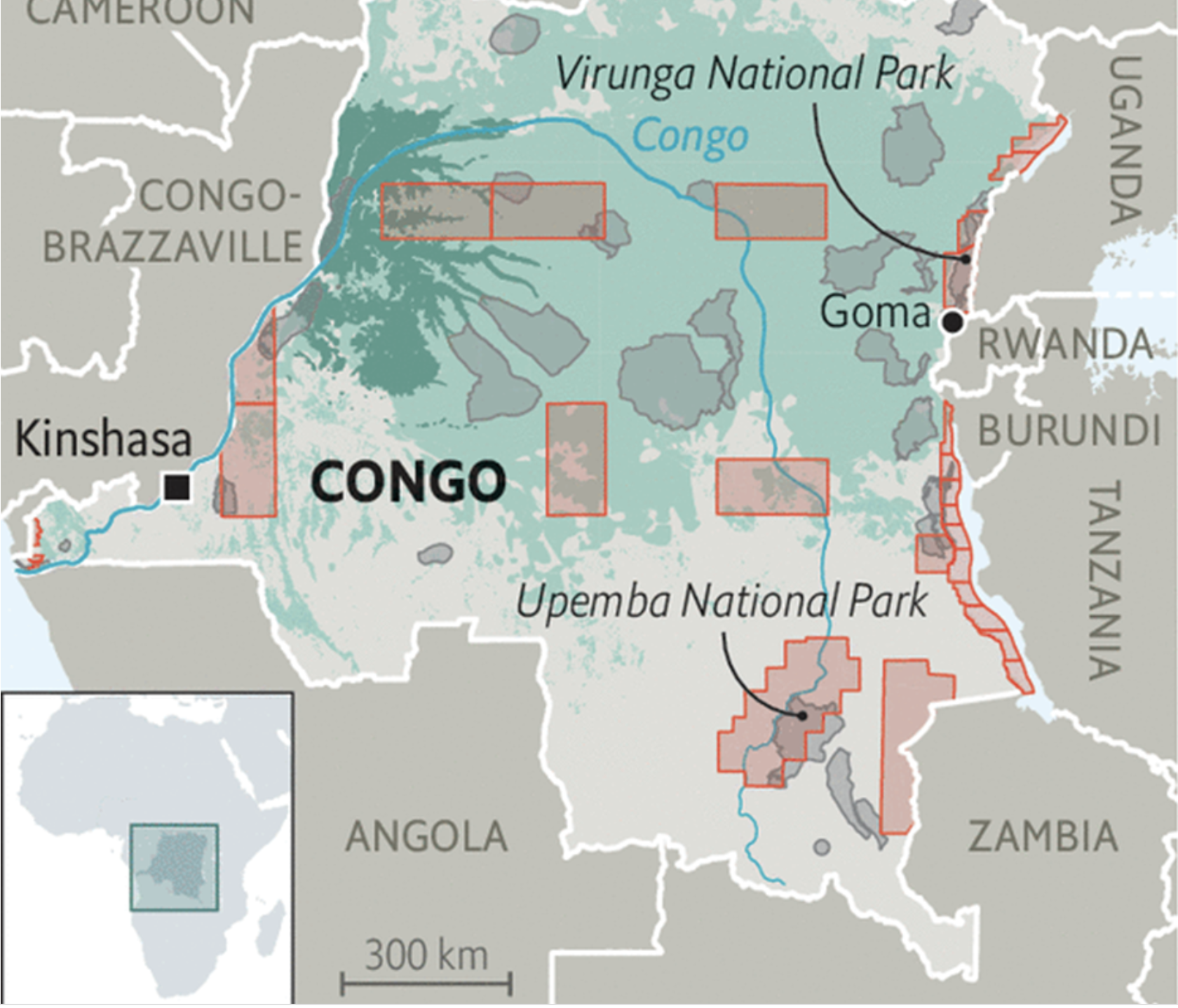The Democratic Republic of Congo (DRC) is auctioning off the rights for exploratory oil & gas permits in parts of the Congo River Basin to support its economic growth. This highlights the importance of the voluntary carbon markets (VCM) and demands an urgent call to scale.
The situation
Between now and April earlier this year the Congolese Government approved a closed auction of 30 blocks of land for enabling oil (27) and gas (3) exploitation. Of these, at least 9 blocks fall in the Cuvette Central region, part of the Congo River Basin — an essential carbon sequestering ecosystem representing 12.5% of global rainforests, second only to the Amazon Rainforest.

The Congo River Basin in its entirety accounts for roughly thirty Gigatonnes of carbon storage, the equivalent of ten global carbon years (estimates vary — I’ve gone for the lowest). Calculations of sequestration in the areas being sold account for roughly the equivalent of three years emissions. That’s right, three global years of manufacturing, data storage, flights, car journeys, shipping, shopping from China to the UK all in these pockets of land now being sold to extract oil — oil that will exacerbate the problems we’re already facing.
The situation is made all the more complex by challenging political and economic dynamics on the ground. It’s important to acknowledge that Westerners looking in from the outside — ourselves included — should only move forward on solutions that are informed by and led by local activists on the ground. Something that the solutions we reference later embed in the project development process.
Why’s it happening?
Well, quite simply, DRC needs money for its nation’s development. In the 1960s, following its independence from Leopold’s brutal colonialist rule, the DRC was the second most developed African nation. It successfully tapped into its vast natural resources and had a relatively productive agricultural sector. Unfortunately, due to decades of war and instability, the situation is now vastly different.
The DRC has the 8th lowest ranked GDP per capita amongst countries within the UN and the 13th lowest by measurement of the Human Development Index (an Index that measures life expectancy, time in school, and per capita income). The World Bank estimates that roughly 73% of the population (60 million) were living on less than $1.90 a day (2018).

On a macro level the war in Ukraine has caused demand for oil and natural gas to sky-rocket with prices following suit, providing an obvious catalyst for this decision.
With all things considered it’s easy to understand the position of the Congolese government with estimates suggesting the sale and development of this land could generate billions annually for the nation (a roughly 25% increase on current GDP).
‘Our priority is not to save the planet,’ said Tosi Mpanu Mpanu, the nation’s lead representative on climate issues and an adviser to the minister of hydrocarbons — and I personally couldn’t agree more. To expect developing nations to foot the bill is a double standard and an iteration of Climate Colonialism that we absolutely need to avoid. The burden of climate action belongs to the Western nations who have benefited from industrialization over the last 170 years.
The solution?
Financing. Decisions are made based on financial incentives, unfortunately the devastation of habitats and ecosystems does not carry the same leverage. So where do we get the money (ideally without developing more oil fields)? Keeping in mind there will be potentially billions generated if these areas of land are developed. Well, there’s two options:
Governmental Aid
Last year the DRC government endorsed a 10-year agreement to protect its rainforest. The deal included international pledges of $500 million for the DRC, one of the world’s poorest nations, over the first five years.
Obviously this doesn’t scratch the surface and with more immediate issues in Western Europe I wouldn’t expect this figure to change in the near term. It’s not even close to the figure needed to disincentivize oil and gas expansion — an industry with focused interests and deeper pockets.
Private sector, specifically the VCM.
The other solution and arguably the most realistic is the Carbon markets. Many of you reading this are likely very familiar with why the carbon markets work, but I’ll very briefly touch on it.
The carbon markets enable carbon emitters worldwide to offset their emissions by purchasing carbon credits. Carbon credits are generated by projects that either avoid, reduce or remove carbon in the atmosphere. Examples of projects include protecting existing land that sequesters carbon (avoidance), implementing energy efficiency projects (reduction), or rehabilitating land so that it sequesters carbon (removal).
The initial investment is rewarded by the issuance of credits which can then be sold to the open market for a return on their investment. In higher quality projects >70% of this trickles down to the project owners and the local population. As can be seen below, the volumes in and the value of the market are growing exponentially, showing an increasingly liquid source of capital to implement climate solutions.

There have been dozens of successful cases where REDD+ (Reducing emissions from Deforestation and forest Degradation) projects (one type of methodology that protects existing natural habitats) have provided a viable financial alternative to deforestation. Take Rimba Raya for example. Located in Central Kalimantan, Indonesian Borneo, is one of the largest REDD+ peat swamp forest projects in the world, avoiding nearly 130 million tonnes of carbon emissions. Rimba Raya generates carbon credits from High Conservation Value (HCV) peat swamp forest within the carbon accounting area.
The Rimba Raya initiative not only reduces carbon, but also meets all 17 of the United Nations’ Sustainable Development Goals, which strive to end poverty, and ensure prosperity for all.
Ironically some vocal carbon market detractors, those now demanding immediate protection of the Congolese Basin, argue Carbon Offsets are a scam, but it’s exactly these mechanisms that would have, and are, protecting nature based ecosystems globally. Sure it’s not a perfect solution, but it monetizes carbon, it brings value to otherwise unused land and supports local communities. These facts can’t be ignored.
A(nother) call to scale
The markets need to act now to avoid this happening elsewhere. We need to continue to scale fast whilst maintaining quality and rigor, and further financially disincentivise governments from choosing big oil over the climate.
Of course, it’s easier said than done. There’s a lot the market needs to develop before it has the capabilities to scale and is seen as a legitimate alternative to fossil fuels, logging, agriculture, etc. We need to keep developing the tools that speed up the development process, through data tracking and transfer, and digital Monitoring Reporting & Verification (MRV) — some of which is already being implemented. Forward markets can unlock essential supply liquidity that’s hamstrung by lack of finance (look out for our upcoming report on this) and prices need to continue to be pushed higher by attracting new demand side participants to the VCM.
While the current situation is extremely complex, I’m still optimistic we can turn it around. We have the tools, the mechanisms and the collective desire to use financial incentives to protect the environment and support local economies. As we’ve seen the market is growing at an exponential rate, but is still no where near the size we need it to be to compete for these precious pockets of earth.
We need to work together, not just in the ReFi (regenerative finance) echo chamber, but with governments, NGOs and communities on the ground. We need to continue to build the tools to scale participation and price in the marketplace whilst conserving quality, and we need to keep shouting about all the good the VCM is already doing and how much it can do if financed effectively.
What can I do right now?
At the news of the upcoming government auction, members of the Web3 community are coming together to engage with the auction and raise funds to try and co-create nature-based revenue streams with the Congolese people. One of the key takeaways so far has been the importance of centering and engaging local activists on the ground. We therefore encourage anyone who wishes to engage to listen closely to communities on the ground in order to determine where and how to helpfully support.
In addition to this please see the following petitions and news links:
#SaveCongoRainforest (greenpeaceafrica.org)
Save Congo Rainforest — Climate Justice for Africa (climatejustice4africa.org)





